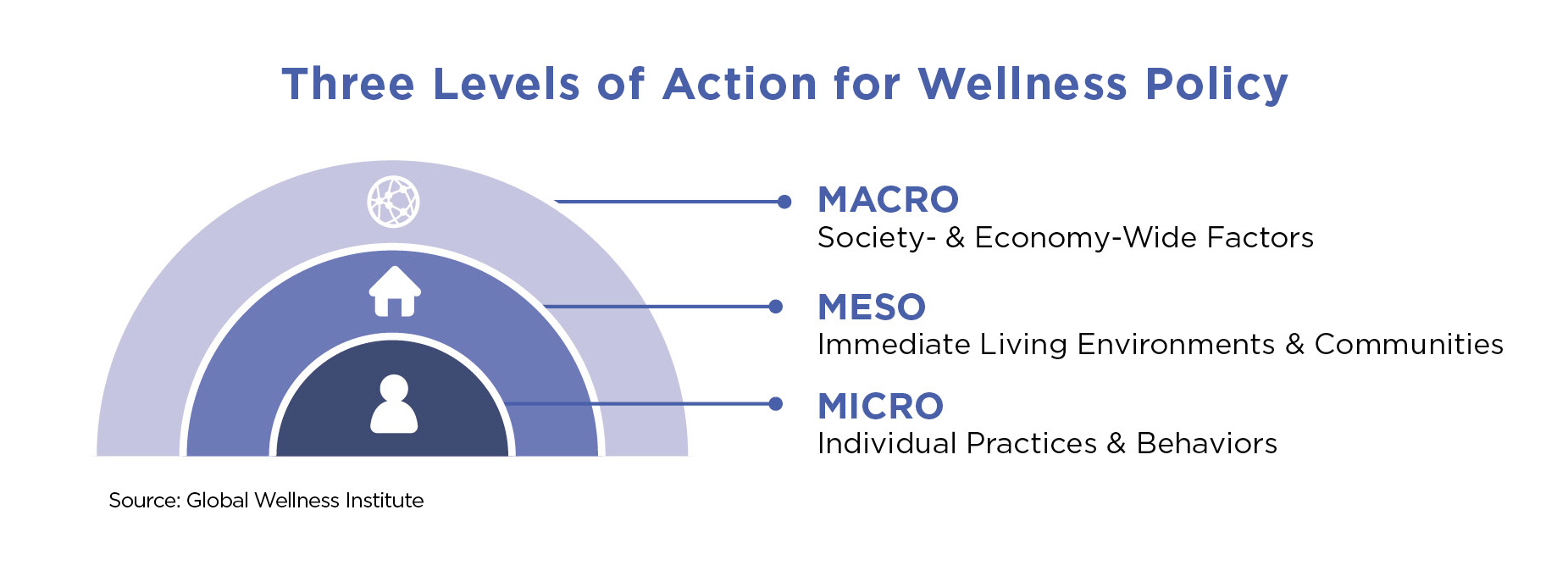WHAT IS WELLNESS POLICY?
Definition of wellness policy
The Global Wellness Institute defines wellness policy as follows: Wellness policy is a set of cross-cutting actions that encourage healthy lifestyles and create supportive environments for human health and well-being.
Wellness is a lens through which we can reshape public policy and work toward improving human health, happiness, and well-being outcomes. Wellness policy complements and supports health, public health, and happiness/well-being policies, but it is not the same thing.
Levels of action for wellness policy
Public policies can be formulated to shape our wellness at three different levels:
- Micro-level wellness policy: Encouraging individuals to proactively make healthy choices, establish healthy habits, and live healthy lifestyles.
- Meso-level wellness policy: Creating living environments that support and encourage healthy behaviors and lifestyles.
- Macro-level policy: Reshaping all policies related to our wider society and economy, with the aim of improving human health and well-being.
In many cases, macro-level policies such as reducing poverty, stopping armed conflicts, or addressing climate change will have a greater impact on our health and well-being than the meso- and micro-level policies targeting individual behaviors and community environments. Macro-level policies – covering the entire range of public policy action – are vitally important to human health and well-being. Addressing these issues is critical, but it requires long-term, systemic changes, as well as political will and compromises, which can be difficult to achieve.
In GWI’s Wellness Policy Series, we focus primarily on actions at the micro- and meso-levels. Wellness policies at the micro- and meso-levels complement national-level well-being policy efforts. They can be implemented and have benefits for people immediately, even while we wait for the glacial progress in solving our long-term macro crises and shifting our overarching policy priorities toward well-being.
Who benefits from wellness policy
Wellness policies can target the needs of specific populations and lifespan groups, including underserved and vulnerable groups such as children and seniors. Wellness policy is especially critical for lower-income and disadvantaged populations, who are at higher risk for poor health and are not well-served by the private wellness market.
Wellness is not a luxury. It is not a “hierarchy of needs,” where basic needs (e.g., safety, employment, food) must be met before we can pursue “loftier” wellness practices like exercise, healthy diets, or meditation. To the contrary, wellness is a basic and critical resource that we all need, no matter our life circumstances. Even those living in the worst macro-level circumstances (e.g., war zones, refugee camps) can benefit from individual wellness practices and pathways to help them cope, build resilience, and deal with adversity. Wellness policies at the micro- and meso-levels can be implemented and have benefits for people immediately, even while we wait for the glacial progress in solving our long-term macro crises and shifting our overarching policy priorities toward well-being.
Key focus areas for wellness policy
GWI has identified seven domains in which wellness policy can encourage healthy behaviors and lifestyles and that create wellness-supporting environments. These seven domains do not function independently from one another. They are closely interrelated, and policy actions within one domain can have impacts across other areas. For example, policies focusing on the built environment can affect our individual behaviors related to physical activity, mental wellness, and healthy eating. Policies that encourage physical activity can have an impact on mental wellness.
GWI’s Wellness Policy Series includes seven toolkits that address these seven domains in detail. Stakeholders working in many government functions, industry sectors, and communities can take action across these domains, in both large and small ways, to spearhead bringing wellness to all.
Wellness Policy Domains Covered in GWI’s Wellness Policy Series
Wellness Activities and Lifestyles
- Healthy Eating
- Physical Activity
- Mental Wellness
- Traditional & Complementary Medicine
Wellness-Supporting Environments
- Wellness in the Built Environment
- Wellness at Work
- Wellness in Tourism
For more information:
- To learn more about wellness, policy, see GWI’s 2022-2023 Wellness Policy Series. This series is a compilation of nine reports, which aim to define wellness policy, articulate why it is needed, and provide a framework and set of strategies for implementing wellness policies across many domains of wellness.

























































